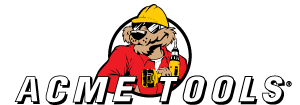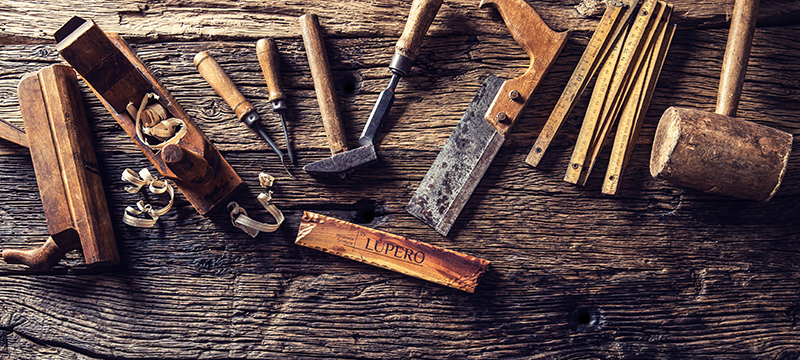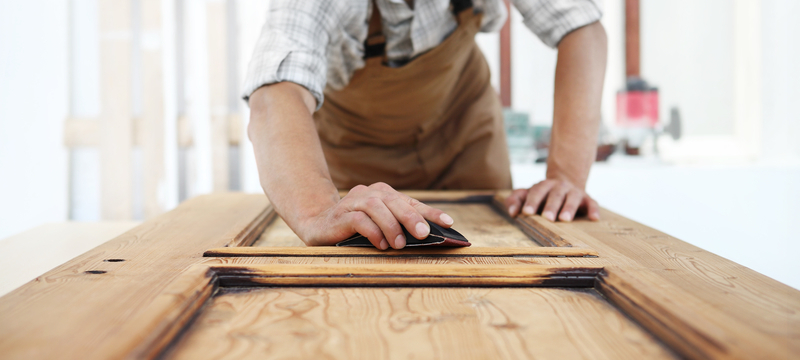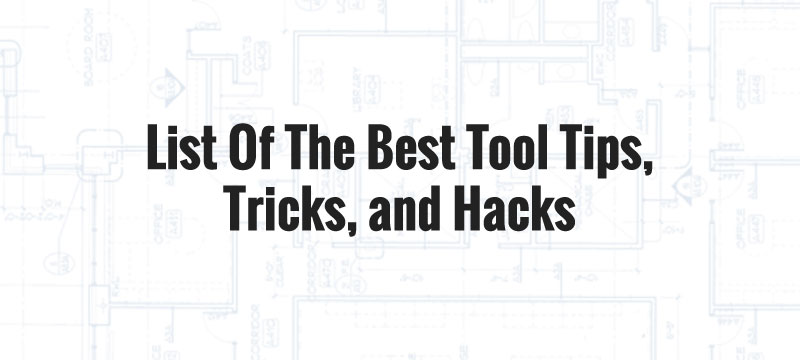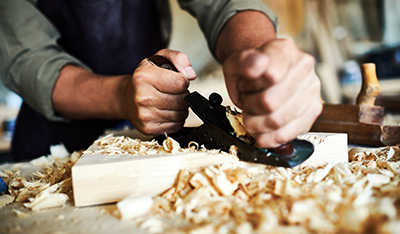
Whether as a hobby or as a career getting into woodworking can seem like a daunting task with the myriad of hand tools, power tools, and more available. The saws alone are enough to make your head spin. Do I need a table saw? How about a miter saw? What is a jigsaw?
But once you get started with the beginner tools, you can upgrade to bigger and better tools to refine your craft even further. Our list of the best woodworking tools for beginners will ensure you have everything you need to start your workshop and build your dreams.
Woodworking Power Tools
Hand tools are great for smaller work where you need a detailed touch, but sometimes you just need to get rough cuts out of your boards. Woodworking power tools make life easier with their speed, which makes you more efficient in the workshop. There are plenty of power tools every workshop should have, but this list will get you started before you worry about outfitting an entire workshop.
Table Saw
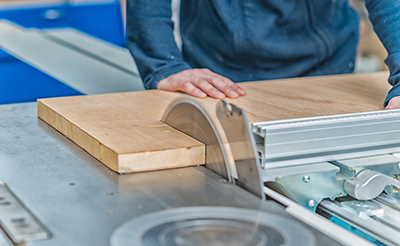
A table saw is one of the most important tools in the shop. It’s big and bulky so depending on space, start small with a tabletop table saw. The table saw rips and cuts straight lines in large pieces of material, which is something you’ll be doing a lot of. It saves you time and makes more accurate long cuts than you could with a circular saw.
Circular Saw
Although a circular saw isn’t great for longer cuts, it does serve an important role in every workshop. They work great for making quick cuts with power or if you’re breaking down materials and don’t need to worry about accuracy so much. A cordless saw is a good option in a workshop where you don’t want to get tripped up by cords.
Orbital Sander
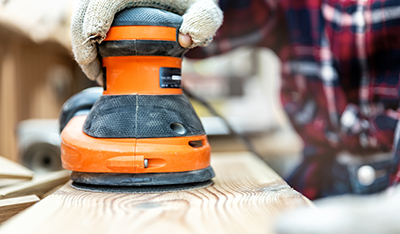
Sanding a large project by hand can be miserable and lead to you giving up before you finish. Opt for an orbital sander to prevent hand fatigue and save tons of time. An orbital sander smooths large surfaces quickly and can remove paint. There are regular orbital sanders and random orbital sanders. You will get less obvious cross-grain marks with a random orbital sander as it works in a random sequence of ovals.
Router
A router is something you never knew you needed until you have one, and then you’ll wonder how you lived without it. Simply, a router creates finished edges and cuts grooves, but it is so much more than that. It can make even, level cuts on straight and curved edges. They’re also capable of more detailed work, such as shaping decorative molding, cutting dadoes, carving rabbets, recessing door hinges, and more.
Jigsaw
Cutting curves can be a pain. You can easily use a handheld coping saw, but a jigsaw adds power to the tedious task. Jigsaws are great for cutting curves and shapes in wood. The thin blade of a jigsaw makes it easier to maneuver, so you have the flexibility to make those curves. A jigsaw can handle several materials other than wood, including laminate, plastic, thin metal, or ceramic tile.
Dust Collector
A dust collector sometimes called a shop vacuum or wet/dry vacuum, is a must in any workshop. Cutting wood all day makes a huge mess, and you need something powerful to clean it up. A dust collector is like a traditional vacuum on steroids. It’s capable of handling large amounts of materials that are both wet and dry. The larger hose makes it easier to suck up large pieces of debris a regular vacuum couldn’t handle.
Miter Saw

A miter saw is great for making angled cuts on molding or trim work. You’ll find yourself using this tool a lot when making apply named miter joints. Compound miter saws can be swung left or right, and the blade can be tilted at an angle, so you can make both a miter and bevel cut simultaneously. There are some miter saws with a sliding arm, so they’re capable of making longer cuts on wider boards.
Jointer
A jointer isn’t the most vital piece of equipment in your shop, but it surely saves a ton of time. When working with rough lumber, a jointer flattens and squares the face and edge of boards. They’re great for fixing cupped boards or removing twists in boards. This type of work could probably be done with hand tools, but a jointer saves you a ton of time and guarantees a perfectly flat, square board before using a planer on it.
Drill/Driver
This is as simple as it gets; the drill/driver. It’s not exciting, but it’s one of the most important tools in your woodworking shop. Even outside the shop, it’s one of your most important tools. A drill/driver is great for drilling holes or driving screws. While woodworking, you’ll find many instances where you’ll need to drill a hole, whether it’s a pilot hole or a large hole for a dowel. Inserts screws. Very versatile.
Impact Driver
An impact driver works very similarly to a drill/driver, and many would say you don’t need both, but things will be easier if you do. If working with harder woods, an impact driver is the way to go as it has a higher torque to make it easier to get through the harder woods. An impact wrench is also great for jobs where you’ll be inserting a lot of screws, as it will save you a bunch of time.
Woodworking Hand Tools
Sometimes, especially in woodworking, your project needs a finer touch, and you need to turn to hand tools. Some are more important than others, but each of the following tools is a must in your tool box. You may need to fine-tune the shape of a board or make very precise cuts that power tools aren’t capable of. Some hand tools work in conjunction with power tools, such as a clamp holding a project in place while making a cut with a jigsaw. Regardless, each hand tool is a pivotal part of your process.
Planer
Planes work similar to sanding tools, but they cut the wood with a fixed blade. They shave down a board to make it thicker or thinner while making it smoother at the same time. There are several kinds of planes available, including a jack plane, block plane, joining plane, rabbet plane, and more. If you only have the money for one, a jack plane is what you’ll want as it’s the workhorse removing a lot of material at once. Block planes work well for tighter areas due to their smaller size, and rabbet planes are good for cutting right-angle grooves along board edge grain.
Clamps
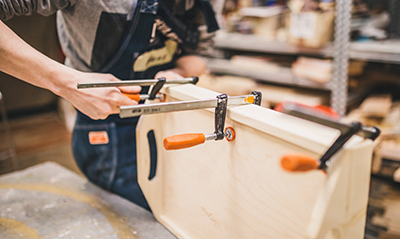
The legendary third hand of any woodworker is the clamp. Clamps hold work while gluing pieces or driving nails and screws. There are several clamps a beginner should have in their arsenal. The main two are pipe clamps and bar clamps. Pipe clamps are great because they work in tandem with galvanized pipes. That combo means you can use short and long pipes, giving you many different options for how wide you need the clamp to be. Bar clamps are a good counterpoint to pipe clamps that are large and heavy; they’re small and easy to use for daily tasks in the shop.
Tape Measure
Your work can’t really go anywhere on a project if you don’t have a quality tape measure. In woodworking, there are several types of measuring devices you’ll need, but a retractable steel tape measure is the best one to start with. Unless you’re working on a larger project, try to get a smaller length tape measure that won’t take up a bunch of space in your tool belt. Other measuring devices include flexible reel tapes, folding rules, marking gauges, and yardsticks or straight edges.
Speed Square
There are several types of squares that can make woodworking easier, but a speed square is one that can serve as a jack-of-all-trades. The main job of a speed square is checking 90- and 45-degree angles and marking straight lines. Although, a speed square is capable of so much more. It can find roof pitches, guide your circular saw to make straighter cuts, and is actually capable of marking any angle from 0-90 degrees. Other types of squares include framing, tri, combination, miter, and bevel squares.
Hand Saw
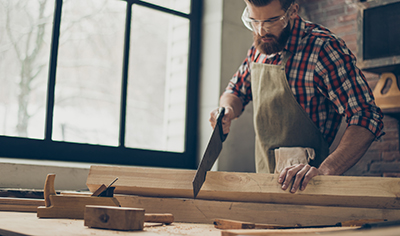
The power of circular saws, table saws, jigsaws, and band saws is great, but sometimes you need a cut with more precision. A hand saw is an excellent choice for easy, quick cuts where a detailed, exact cut is necessary. There are several kinds of hand saws that should be in every workshop, such as coping saws, backsaws, ripping saws, crosscut saws, combination saws, and many more. Each saw has a specific purpose, including cutting with or against the wood grain, one saw does both, another creates curved cuts, and one is used for miter cuts.
Hammer
A hammer is a must for every trade out there, and woodworking is not different. You’ll need a handful of different hammers while woodworking that are capable of handling different tasks. A finishing hammer has a smooth face with pronounced claws. A framing hammer is heavier and built to handle tougher jobs so you’ll use it less. Tack hammers are for smaller work and feature two different head sizes for added versatility. Tack hammers don’t have any claws.
Mallet
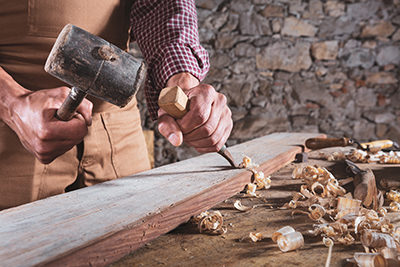
A mallet is the same concept as a hammer but serves an entirely different purpose in the workshop. A mallet’s main function is driving dowels or chisels. Mallets have large wooden or leather heads. The softer head of a mallet is built to absorb shock instead of delivering it as a steel hammer does. Mallets also leave minimal striking marks, so they’re perfect for woodworking projects that you want to look clean. A mallet is a must for any chisel work as it pushes a chisel smoothly through the wood.
Chisels
You have a good mallet, and now you need to find its partner in a chisel. A chisel is used for joinery, shaping, paring, carving, shaving surfaces, and cutting grooves and mortises. But, you’ll need more than just one chisel to do quality work. Thankfully, chisels are usually sold in sets of different sizes. A set of bevel edge chisels is a good starting point for beginners as it can tackle the majority of tasks and won’t break the bank. There are several other styles of chisels that are more specialized, such as mortise or bench chisels, but they aren’t required for a beginner.
PPE
In the woodworking industry, personal protective equipment, or PPE, is your best friend. In a typical woodshop, debris is often flying around that can get in your eyes or lungs, causing pain. Prolonged exposure can lead to lifelong injury.
Safety Glasses

Whether you’re drilling holes, cutting pieces of wood, routing edges, or adding finishing touches to a project with stain, you’re going to want some decent safety glasses. Glasses protect against flying debris in the shop. You can go a step further and wear goggles, which will protect against dust and chemical vapors.
Hearing Protection
Power tools are loud, especially in an enclosed space such as a workshop. Heed that simple fact and wear hearing protection to prevent any injury to your eardrums. You can go with earmuffs or simple earplugs. Earmuffs are preferable because you can easily hang them around your neck when not in use. This also keeps them in one place if you need to put them back on for another cut.
Dust Mask
A workshop is full of sawdust and chemicals. A dust mask, or respirator, will keep dust particles out of your lungs and protect against dangerous fumes. While sanding or stripping wood, sawdust and paint particles fly into the air, and a mask will prevent you from breathing them in. Always wear a mask while spray painting or staining as the fumes from the compounds can get inhaled, leading to injury.

